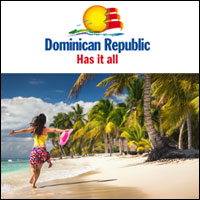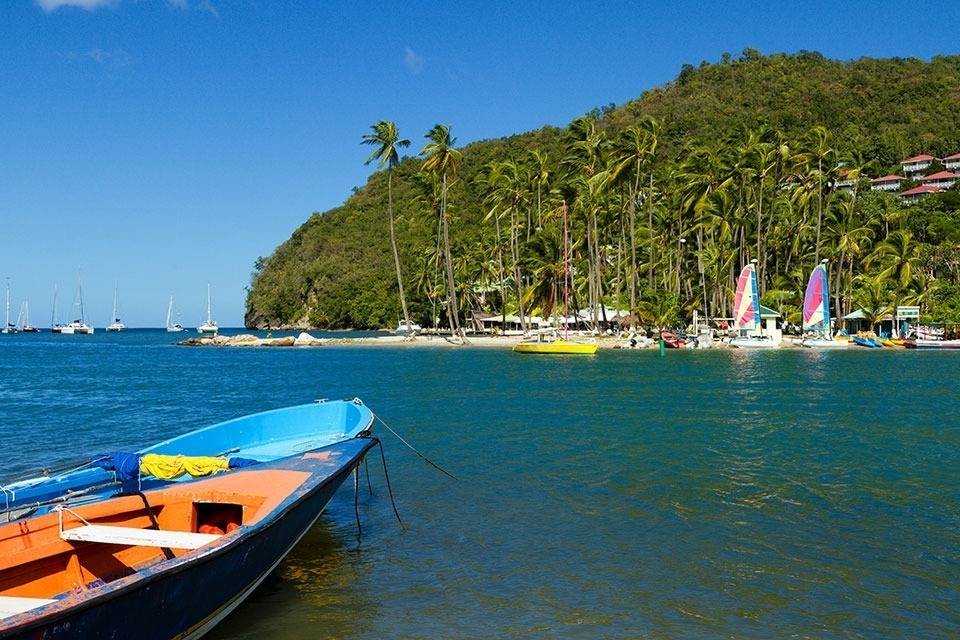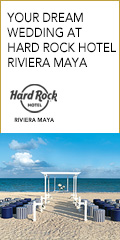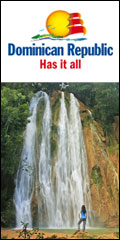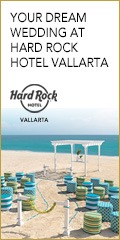
St. Lucia
Destinations
Anguilla
Antigua & Barbuda
Aruba
Bahamas
Barbados
Belize
Bermuda
Bonaire
British Virgin Islands
Cayman Islands
Costa Rica
Curacao
Dominica
Dominican Republic
Grenada
Jamaica
Puerto Rico
St. Barts
St. Kitts & Nevis
St. Lucia
St. Maarten
St. Martin
St. Vincent & The Grenadines
Trinidad & Tobago
Turks & Caicos Islands
U.S. Virgin Islands
Subscribe to
Digital Magazines
Island Adventures In St. Lucia
The island’s capital, Castries, is one of the most modern cities in the Caribbean due to four devastating fires between 1796 and 1948. Much of the city is newly built, however there are still old wooden buildings on the streets with graceful balconies and latticework. It is truly picturesque.
In Derek Walcott Square, named in honor of St. Lucia’s Nobel Laureate for literature, you’ll find a monument to St. Lucia’s veterans and a large, 400-year-old samaan tree. At the eastern end of the square is the Cathedral of the Immaculate Conception. You should not miss the opportunity to shop for exotic fruits and vegetables at the open-air market on Jerome Street, especially on the weekends. It is a 100-year-old tradition on the island.
High on the southern side of Castries is Morne Fortune. The road leading up to the peak provides spectacular views of the city and yacht-filled harbor.
Following the main encircling road on St. Lucia, head south and you’ll hit the Cul de Sac valley, which is filled with acres of banana plantations. A few more miles of winding road finds you at Marigot Bay, one of the most beautiful ports in the Caribbean. Here is where you can watch silkscreens being created at Bagshaw Studio. It was also the setting for the movie Doctor Doolittle.
The road then twists and climbs through the western edge of the rainforest, where the indigenous St. Lucia parrot calls this 19,000-acre paradise home. Guides can take you through the rainforest and entice you with samples of the exotic fruits along the way. A leap into a refreshing waterfall is also part of the tour, so dress appropriately.
For a mysterious experience, try to catch a glimpse of The Thing, St. Lucia’s own sea monster. Myth says it can be seen at night near the Anse Chastanet.
Not far from the Pitons are the Sulpher Springs. This seven-acre wonder is said to be the world’s only drive-in volcano, and a visit reveals hot bubbling streams and pools of sulphur.
Two historical houses in Soufriere, Soufriere Estate and Morne Coubaril, provide insight into the history of St. Lucia. Morne Coubaril, the first major estate established in St. Lucia, has a recreated slave village and the remains of a sugar mill. A tour around the estate will explain the ancient ways of processing cocoa, copra and sugar. This comes highly recommended.
Nearby are the Diamond Baths and Waterfalls and Botanical Gardens, originally built in 1785. For a small fee, you can tour the colorful gardens, and enjoy a dip in the steaming baths. At the extreme southern tip of St. Lucia is Moule & Chique peninsula with a lighthouse. The cliffs harbor numerous sea birds and offer superb views south to St. Vincent and the Grenadines.
Also found on the southernmost part of the island is Vieux Fort, one of the oldest settlements on the island and the boarding place for a trip to Marie Islands Nature Reserve, which is home to two indigenous species found nowhere else in the world, the nonpoisonous couresse grass snake and the St. Lucia ground lizard. Nature lovers will also want to check out the Fregate Islands for their habitat of frigate birds. On the north end of the island, the 40-acre Pigeon Island National Park offers beautiful beaches, an 18th-century naval garrison and a British fort. In 1550, it was the hideout of a notorious French privateer and it is said to still hold some pirate’s treasure.
At the island’s western tip lies Fort Rodney, with two restaurants and a couple of secluded beaches that are worth visiting. Today, it is the stage for the famous St. Lucia Jazz Festival and hosts the Atlantic Rally for Cruisers, an international yacht race. Besides sailing, snorkeling and diving are also popular at Anse Chastanet and Anse Couchon due to their amazing underwater landscape. Windsurfers prefer Cas en Bas and Vieux Fort because of the consistent breeze.
If a true taste of the islands is what completes a trip, then the Fond Latisab Creole Park is a must see. The tour of Fond Latisab shows how traditional St. Lucian dishes are prepared. Demonstrations on the tour include; how to prepare cassava bread , how to cook using macambou leaves, how to catch crawfish in the river, and even the techniques to collect honey from beehives.
Tour the Fond Doux Estate for a true plantation experience. The tour even includes the chance to sample local fruit juices and rum punch. A Creole lunch is provided after the tour.
For a look at how some of St. Lucia’s most renowned crops are grown, stop by the Marquis Estate which shows production of banana and copra, the main exports of the island.
Diving enthusiasts will find heaven in St. Lucia’s waters. Must see dive locations include; Keyhole Pinnacles with 4 sea mounts that rise from the deep to crack the ocean’s surface and Superman’s Flight a drift dive wall that drops 1,600 feet.
Under water photographers must dive Fairy land, where the ecosystem has allowed clean preservation of coral and sponges by the drift of strong currents.








